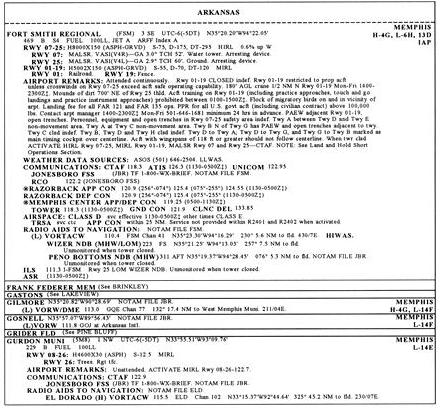
When a pilot flys into a different airport, it is important to review the current data for that airport. This data can provide the pilot with information such as communication frequencies, services available, closed runways, or airport construction, etc. Three common sources of information are:
• Aeronautical Charts
• Airport/Facility Directory (A/FD)
• Notices to Airmen (NOTAMs)
Aeronautical Charts
Aeronautical charts provide specific information on airports. Chapter 8 contains an excerpt from an aeronautical chart and an aeronautical chart legend which provides guidance on interpreting the information on the chart. Refer to Chapter 8, figures 8-1 and 8-22 for chart information.
Airport/Facility Directory (A/FD)
The Airport/Facility Directory provides the most comprehensive information on a given airport. It contains information on airports, heliports, and seaplane bases which are open to the public. The A/FD’s are contained in seven books which are organized by regions. These A/FD’s are revised every 8 weeks. Figure 6-2 contains an excerpt from a directory. For a complete listing of information provided in an A/FD and how the information may be decoded, a pilot should refer to the “Directory Legend Sample” located in the front of each A/FD.
Figure 6-1.—Recommended communication procedures.
| FACILITY AT AIRPORT
|
FREQUENCY USE
|
COMMUNICATION/BROADCAST PROCEDURES
|
||
| OUTBOUND
|
INBOUND
|
PRACTICE
INSTRUMENT PPROACH |
||
| UNICOM (No
Tower of FSS) |
Communicate with UNICOM station on published CTAF frequency (122.7, 122.8, 122.725, 122.975, or 123.0). If unable to contact UNICOM station, use self-announce procedures on CTAF. | Before taxiing and before taxiing on the runway for departure.
|
10 miles out entering downwind, base, final. Leaving the runway.
|
|
| No Tower, FSS, or UNICOM
|
Self-announce on MULTICOM frequency
|
Before taxiing and before taxiing on the runway for departure.
|
10 miles out entering downwind, base, final. Leaving the runway.
|
Departing final approach fix (name) or on final approach segment inbound.
|
| No Tower in operation, FSS open
|
Communicate with FSS on CTAF frequency.
|
Before taxiing and before taxiing on the runway for departure.
|
10 miles out entering downwind, base, final. Leaving the runway. | Approach completed / terminated.
|
| FSS closed (No Tower)
|
Self-announce on CTAF.
|
Before taxiing and before taxiing on the runway for departure.
|
10 miles out entering downwind, base, final. Leaving the runway. | |
| Tower or FSS not in operation
|
Self-announce on CTAF.
|
Before taxiing and before taxiing on the runway for departure.
|
10 miles out entering downwind, base, final. Leaving the runway. |
 |
In the back of each A/FD, there is information such as special notices, parachute jumping areas, and facility telephone numbers, etc. It would be helpful to review an A/FD to become familiar with the information they contain.
Notices to Airmen (NOTAMs)
Notices to Airmen provide the most current information available. They provide information on airports and changes which affect the national airspace system that are time-critical and in particular are of concern to instrument flight rule (IFR) operations. NOTAM information is classified into three categories. These are NOTAM-D or distant, NOTAM-L or local, and flight data center (FDC) NOTAMs. NOTAM-Ds are attached to hourly weather reports and are available at flight service stations (AFSS/FSS). NOTAM-Ls include items of a local nature such as taxiway closures, construction near a runway, etc. These NOTAMs are maintained at the FSS nearest the airport affected. NOTAM-Ls must be requested from an FSS other than the one nearest the local airport for which the NOTAM was issued. FDC NOTAMs are issued by the National Flight Data Center and contain regulatory information such as temporary flight restrictions or an amendment to instrument approach procedure. The NOTAM-Ds and FDC NOTAMs are contained in the Notices to Airmen publication which is issued every 14 days. Prior to any flight, pilots should check for any NOTAMs which could affect their intended flight.